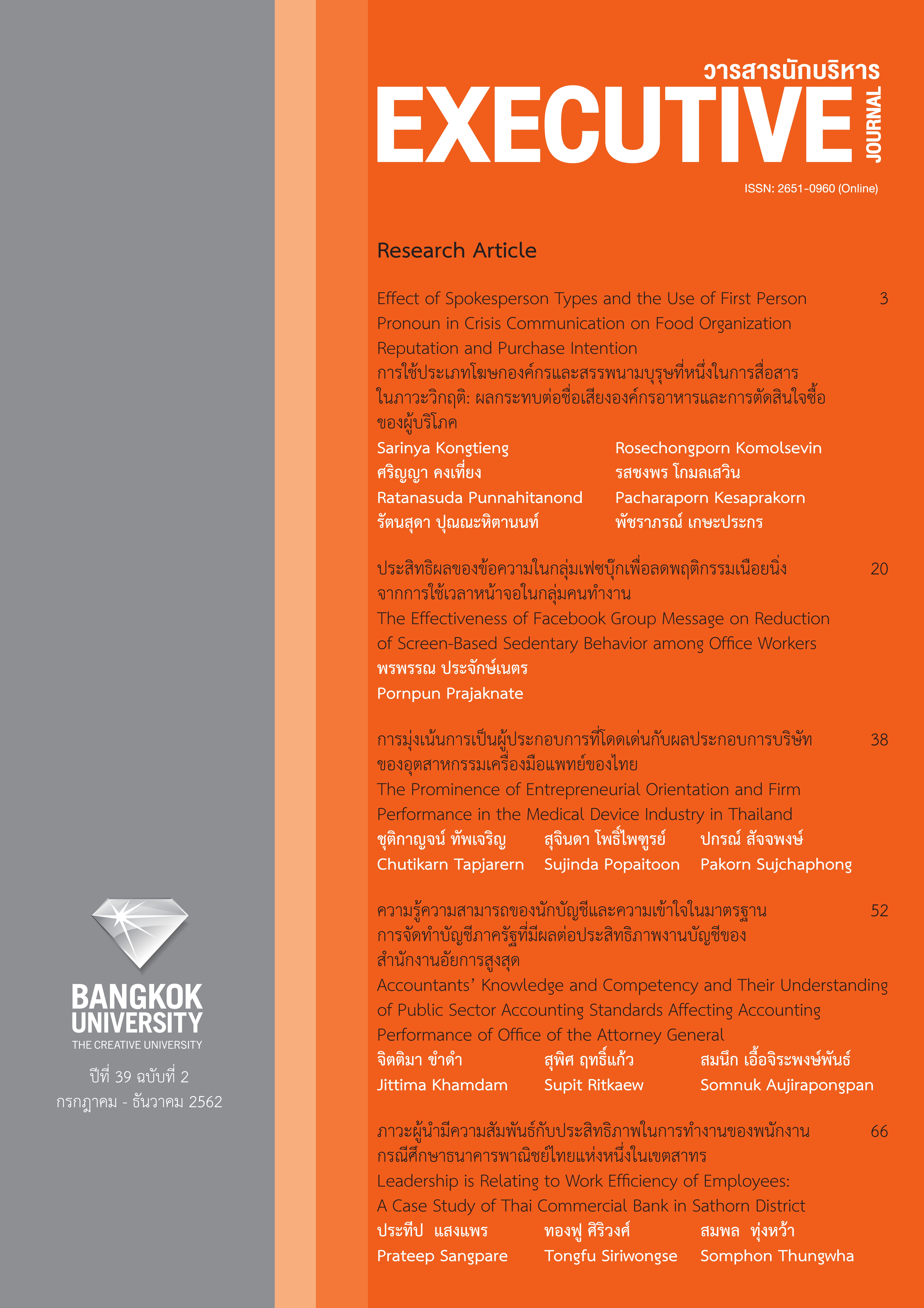Total Quality Management Practices to Improve Productivity in the Production Oriented Organization
Main Article Content
Abstract
The total quality management is one concept that helps increase productivity in 7 factors, technology and continuous improvement, labours, speed, quality, customer satisfaction, costs of quality, and financial aspects, which are the forms of input and output, and using performance measurement system incorporating both financial and non-financial performance measures. The purpose of this study is to review the research of total quality management applied to improve productivity in the production oriented organization. The cause and effect relationships showed the factors that are leading and lagging indicators in accordance with the principle of performance measurement leading to the benefit of developing higher efficiency and effectiveness.
Article Details
The manuscript submitted for publication must be the original version, submitted only to this particular journal with no prior acceptance for publication elsewhere in other academic journals. The manuscript must also not violate the copyright issue by means of plagiarism.
References
Ahire, S., Golhar, D., & Waller, M. (1996). Development and validation of TQM implementation constructs. Decision Sciences, 27(1), 23-56.
Ahmed Al-Dujaili, M. A. (2013). Study of the relation between types of the quality costs and its impact on productivity and costs: A verification in manufacturing industries. Total Quality Management & Business Excellence, 24(3-4), 397–419.
Anderson, J. C., Rungtusanatham, M., & Schroeder, R. G. (1994). A theory of quality management underlying the Deming management method. Academy of Management Review, 19(3), 472-509.
Black, S., & Porter, L. (1996). Identification of the critical factors of TQM. Decision Sciences, 27(1), 1-21.
Buathong, S., & Bangchokdee, S. (2015). Kānchai tūa chī watphon kān dā nœ̄n ngān thāng kānngœ̄n læ mai chai thāng kānngœ̄n phāitai thritsadī kānbō̜rihān chœ̄ng sathānakān [Use of financial and non-financial performance measures within contingency theory]. Journal of Accounting Profession, 11(31), 63-79.
Burgess, T. F. (1990). A review of productivity. Work Study, 39(1), 6-10.
Callaghan, B. (1990). Productivity for profit. Work Study, 39(2), 6-19.
Gupta, M., & Campbell, V. S. (1995). The cost of quality. Production and Inventory Management Journal, 36(3), 43-49.
Gupta, S., & Prasad, A. (2011). Productivity‐based hybrid model: Learning from the Indo‐Japanese and Indian auto sector. Journal of Advances in Management Research, 8(1), 158-171.
Hackman, J. R., & Wageman, R. (1995). Total quality management: Empirical, conceptual and practical issues. Administrative Science Quarterly, 40, 309-342.
Iyer, A., Saranga, H., & Seshadri, S. (2013). Effect of quality management systems and total quality management on productivity before and after: Empirical evidence from the Indian auto component industry. Production and Operations Management, 22(2), 283–301.
Kaplan, R. S., & Norton, D. P. (1996). The balanced scorecard: Translating strategy into action. Boston: Harvard Business School Press.
Khataie, A. H., & Bulgak, A. A. (2013). A cost of quality decision support model for lean manufacturing: Activity‐based costing application. International Journal of Quality & Reliability Management, 30(7), 751-764.
King, R. A. (1989). Manufacturing strategy for productivity improvement. Journal of Business Strategy, 10(2), 62-63.
Kitirach, R. (2018). Khwāmsamphan chœ̄ng sāhēt rawāng kānbō̜rihān khunnaphāp thūa thang ʻongkān phonlakā rō̜dam nœ̄n ngān thī mai pentūa ngœ̄n læ phonlakā rō̜dam nœ̄n ngān thī pentūa ngœ̄n khō̜ng ʻutsāhakam phalit yāng rotyon nai nikhom ʻutsāhakam lǣm chabang [Causal relationships between total quality management, non- financial and financial performance of tire wheel manufacturing industry in Laem Cha Bang industrial estate] (Master’s thesis, Kasetsart University).
Kiyohiko, S. (1986). Japanese worker attitudes: A key factor in productivity. International Journal of Operations & Production Management, 6(1), 42-53.
Magrath, A. (1992). The management of marketing productivity. Journal of Business & Industrial Marketing, 7(4), 49-54.
Misterek, S., Dooley, K. J., & Anderson, J. C. (1992). Productivity as a performance measure. International Journal of Operations & Production Management, 12(1), 29-45.
Mohanty, R. P. (1988). Factors affecting productivity: Perception of Indian manager. Industrial Management & Data Systems, 88(7/8), 21-26.
Mohanty, R. P. (1998). Understanding the integrated linkage: Quality and productivity. Total Quality Management, 9(8), 753-765.
Moore, D. A., & Tenney, E. R. (2012). Time pressure, performance, and productivity. Research on Managing Groups and Teams, 15, 305-326.
Oeij, P. R. A., De Looze, M. P., Ten Have, K., van Rhijn, J. W., & Kuijt‐Evers, L. F. M. (2011). Developing the organization's productivity strategy in various sectors of industry. International Journal of Productivity and Performance Management, 61(1), 93-109.
Phelps, L. D., Parayitam, S., & Olson, B. J. (2007). Edwards Demimg, Mary P. Follett and Frederick W. Taylot: Reconciliation of difference in organization and strategic leadership. Academy of Strategic Management Journal, 6, 1-14.
Powell, T. C. (1995). Total quality management as competitive advantage: A review and empirical study. Strategic Management Journal, 16(1), 15-37.
Sananuch, S. (2016). Thưng wēlā phāk rat tō̜ng wat Productivity [It's time for the government sector to measure productivity]. Retrieved July, 23, 2019, from https://www.ftpi.or.th/2016/7682
Saraph, J. V., Benson, P. G., & Schroeder, R. G. (1989). An instrument for measuring the critical factors of quality management. Decision Sciences, 20(4), 810-829.
Schermerhorn, J. R. (1986). Productivity perspectives in management development. Journal of Management Development, 5(2), 3-6.
Sethi, R. (2000). New product quality and product development teams. Journal of Marketing, 64(2), 1-14.
Shurchuluu, P. (2002). National productivity and competitive strategies for the new millennium. Integrated Manufacturing Systems, 13(6), 408-414.
Srisawad, N. (2013). Khwāmsamphan rawāng kānbō̜rihān khunnaphāp thūa thang ʻongkān (TQM) kap kānphatthanā nawattakam nai ʻutsāhakam ʻāhān sat [The relationship between total quality management (TQM) strategy and innovation in animal feed industries] (Master’s thesis, Kasetsart University).
Stabler, A. (1996). Productivity, performance measurement and management in logistics. Asia Pacific Journal of Marketing and Logistics, 8(2), 46-63.
Stainer, A. (1997). Capital input and total productivity management. Management Decision, 35(3), 224-232.
Stainer, A., & Stainer, L. (1995). Productivity, quality and ethics–a European viewpoint. European Business Review, 95(6), 3-11.
Uyar, A. (2008). An exploratory study on quality costs in Turkish manufacturing companies. International Journal of Quality & Reliability Management, 25(6), 604-620.


